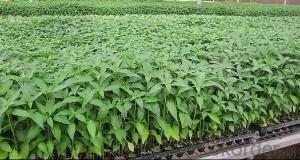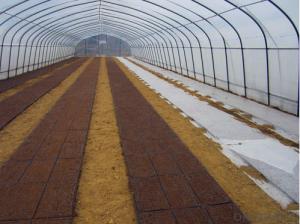Indented Gasket Out Adding Nipple - Micro irrigation - Drip irrigation
- Loading Port:
- Tianjin
- Payment Terms:
- TT OR LC
- Min Order Qty:
- 1500 m²
- Supply Capability:
- 1999999 m²/month
OKorder Service Pledge
OKorder Financial Service
You Might Also Like
Specifications of Irrigation Tape distance 30cm Good Quality :
Indented Gasket Out Adding Nipple - Micro irrigation - Drip irrigation


Indented Gasket Out Adding Nipple - Micro irrigation - Drip irrigation
The Application of Irrigation Tape distance 30cm Good Quality:
The layflat hose has a wealth of residential and commercial applications, and it is usually used for general water transfer purposes as well as for submain.Generally layflat hoses are used in the industry of agriculture,in pipe lining and rehabilitation,in removing waste water,in mine dewatering ,in the chemical industry and even for household chores

The decription of Irrigation Tape distance 30cm Good Quality:
Two layers of PVC bonded together encapsulating high tensile polyester fibers.
Thick wall dimensions and strong yarn structure help products to hold connections and resist bursting.
It assumes the conventional round appearance when pressure is being passed through it and then returns to its flat shape after use.It does not need drying and can be rolled immediately after use.
Indented Gasket Out Adding Nipple - Micro irrigation - Drip irrigation
Features of Irrigation Tape distance 30cm Good Quality:
1.Great durability mainly given by the reinforcement and high-density PVC material.
2.The layflat hoses can have up to 12 inches diameter based on their applications.
3.Extra thickness are added in order to prevent bursting due to pressure in heavy industry.
4.Can be easily rolled up,stored and reused,as it has a very durable construction.
5.The hoses come with a variety of fittings and accessories ensures the water transfer process free of leaking.
6.Temperature range:-5°C~65°C(23~149F)
Indented Gasket Out Adding Nipple - Micro irrigation - Drip irrigation
FAQ Irrigation Tape distance 30cm Good Quality
1.Q:Are you manufactory or trade company?
A:We are the Manufactory specialized in drip irrigation more than 20 years; Our factory have passed IS09000.
2.Q:How can I get the samples?
A:If you need some samples to test, we can make as per your request .You should pay for the transportation freight of samples and our samples cost, while the samples cost can be refundable after you place the order if the amount meets our requirement.
3.Q:How much the transportation freight of samples?
A:The freight depends on the weight and packing size and your area.
4.Q:How long can I expect to get the sample?
A:The samples will be ready for delivery within one week. The samples will be sent via express and arrive in 7-10 days.
5.Q:Can we have our Logo or company name to be printed on your products or package?
A:Sure.Your Logo can be put on your products by Hot Stamping,Printing,Embossing,UV Coating,Silk-screen Printing or Sticker
- Q: How long do plastic mulch films last?
- Plastic mulch films typically last for one growing season, lasting anywhere from three to six months depending on the environmental conditions and the type of plastic used.
- Q: I've broad face and very small eyes... i wanna do plastic surgery... I feel that i have an odd appearance...please suggest me...is there solution for my appearance in plastic surgery..? I dont want broad face... M only 22 ...but people feel that m looking matured with this appearance.... M worried....Is this possible to correct my appearance...??
- Yes, There are many benefits of plastic surgery..like liposuction. See below for more information.
- Q: What classifies a type of surgery as being plastic compared to anything else? What is plastic vs cosmetic surgery? Or are they the same?
- That's a great question so I looked it up. Plastic and Cosmetic surgery deal with improving your looks verses most other surgery would improve your health. (Other than say these surgeries can improve health via happiness and feeling better about yourself) Plastic surgery is classified as improvements treating defects due to disease, accidents, injuries, deformation. Examples, severe burns Cosmetic surgery is improvements when it is not disease or injury related. Odd, I would have thought they were interchangeable and meant the same thing. And it seems to me media does interchange the words.
- Q: I had plastic surgery (chin lipo) it was uneven and had to redone, now its even worse and I have to have someone else fix it. Can I sue my plastic surgeon? Should I demand a partial return on what I paid first and then sue?
- If you demand a partial refund, I think they may consider that as a settlement if you decide to sue...I wouldn't recommend it, but then again, I'm no lawyer. And if the service wasn't done properly, and you have the proof you had to get it fixed, I don't see why you can't sue. I just hope you don't go overboard...get the money it costs to get it redone and a little pain and suffering...that's what I would do at least.
- Q: This question asks about the methods farmers employ to decrease their environmental impact by using agricultural plastic products.
- <p>Farmers can reduce their carbon footprint using agricultural plastic products through several strategies. One is by using biodegradable plastics, which break down naturally and emit fewer greenhouse gases. They also use mulch films to reduce soil erosion and water evaporation, conserving water and reducing the need for irrigation. Additionally, plastic greenhouses help in maintaining optimal growing conditions, reducing the need for energy-intensive heating or cooling. Proper recycling and disposal of used plastics also play a significant role in minimizing environmental impact. By integrating these practices, farmers can make their operations more sustainable and eco-friendly.</p>
- Q: i am currently looking at a pacman frog and was think is a plastic tub good enough for it? please only intelligent answers not animal cruelty stuff.
- Louis; Once ye've researched the Pacman Frog enough to first know its correct, scientific name, then its overall requirements, then ye'll know the answer to most of ye questions and will be ready to take on responsibility for one.
- Q: Are nursery trays suitable for growing ornamental grasses?
- Yes, nursery trays are suitable for growing ornamental grasses. They provide a controlled environment for the grasses to grow and establish their root systems. Additionally, the trays allow for easy transportation and transplanting of the grasses when they are ready to be moved to their permanent location.
- Q: What are ways to recycle plastic bottles by resulting into a piece of art?
- I okorder Hope these are all of some use.
- Q: Can ground cover plants be used to improve soil moisture retention?
- Yes, ground cover plants can be used to improve soil moisture retention. These plants help to reduce evaporation by shading the soil from direct sunlight, which helps to keep the soil moist for longer periods. Additionally, their root systems can help to bind the soil particles together, reducing erosion and improving water infiltration. Overall, ground cover plants can play a crucial role in conserving soil moisture and improving its retention.
- Q: How does ground cover impact the overall water drainage of a garden?
- Ground cover can have a significant impact on the overall water drainage of a garden. When chosen correctly, ground cover plants can help improve water drainage by reducing erosion, promoting infiltration, and preventing runoff. Their dense foliage and extensive root systems can absorb excess water, preventing it from pooling on the surface and causing waterlogging or flooding. Additionally, ground cover plants can help retain moisture in the soil, allowing for better water distribution and reducing the need for irrigation.
Send your message to us
Indented Gasket Out Adding Nipple - Micro irrigation - Drip irrigation
- Loading Port:
- Tianjin
- Payment Terms:
- TT OR LC
- Min Order Qty:
- 1500 m²
- Supply Capability:
- 1999999 m²/month
OKorder Service Pledge
OKorder Financial Service
Similar products
Hot products
Hot Searches
Related keywords























